FC Rouen 1899 earned promotion to France’s third tier, Championnat National, for the 2023/24 season under their 42-year-old manager Maxime D’Ornano. At the time of writing, they’ve played 10 games and earned 17 points, placing them fifth with a game in hand on all but five other sides in the league, including three of those positioned above them.
They’re unbeaten in their four home games this term (winning two and drawing two), while their away record stands at two wins, three draws and one loss.
Rouen are the second team D’Ornano has got promoted to the third tier, having done the same with his previous club, Stade Briochin, back in 2019/20. The Normandy-based club were in the fifth tier as recently as 2018/19, which emphasises how impressive a job the current side and, indeed, their coaches are doing to have them in the position they currently occupy in Championnat National.
It’s been 20 years since Rouen played in Ligue 2 — 39 since they had a Ligue 1 campaign. The top flight is still a long way off, but at the moment, they’re closer than they’ve been in quite some time to climb back to the second rung of the French football ladder.
With that said, we mustn’t get too far ahead of ourselves here. It’s still fairly early days in the 2023/24 season. A lot of football is yet to be played, and Rouen face stiff competition for promotion to the second tier.
This tactical analysis aims to break down D’Ornano’s winning approach with Rouen to determine how Les Diables Rouges have got off to such a great start this term. We’ll analyse some key factors in their tactics resulting in their positive performances and lay out how D’Ornano is achieving such great results just a season after earning promotion to this division.
Build-up play: the goalkeeper’s involvement
Rouen have been impressive in possession this season. They’re a reasonably possession-based side, boasting the sixth-best average possession percentage in France’s third tier right now, and they’ve played the third-most passes per 90 (427.34) in the league, highlighting some key statistics relating to their style of play.
Rouen, under D’Ornano, are quite patient with the ball, even when starting their attacks from the goalkeeper. They don’t generally launch the ball forward; they prefer to build in a more systematic, short pass-heavy manner. This has resulted in their high passing rate (passes per minute of possession) at 14.6 for 2023/24 — the third-highest in Championnat National.
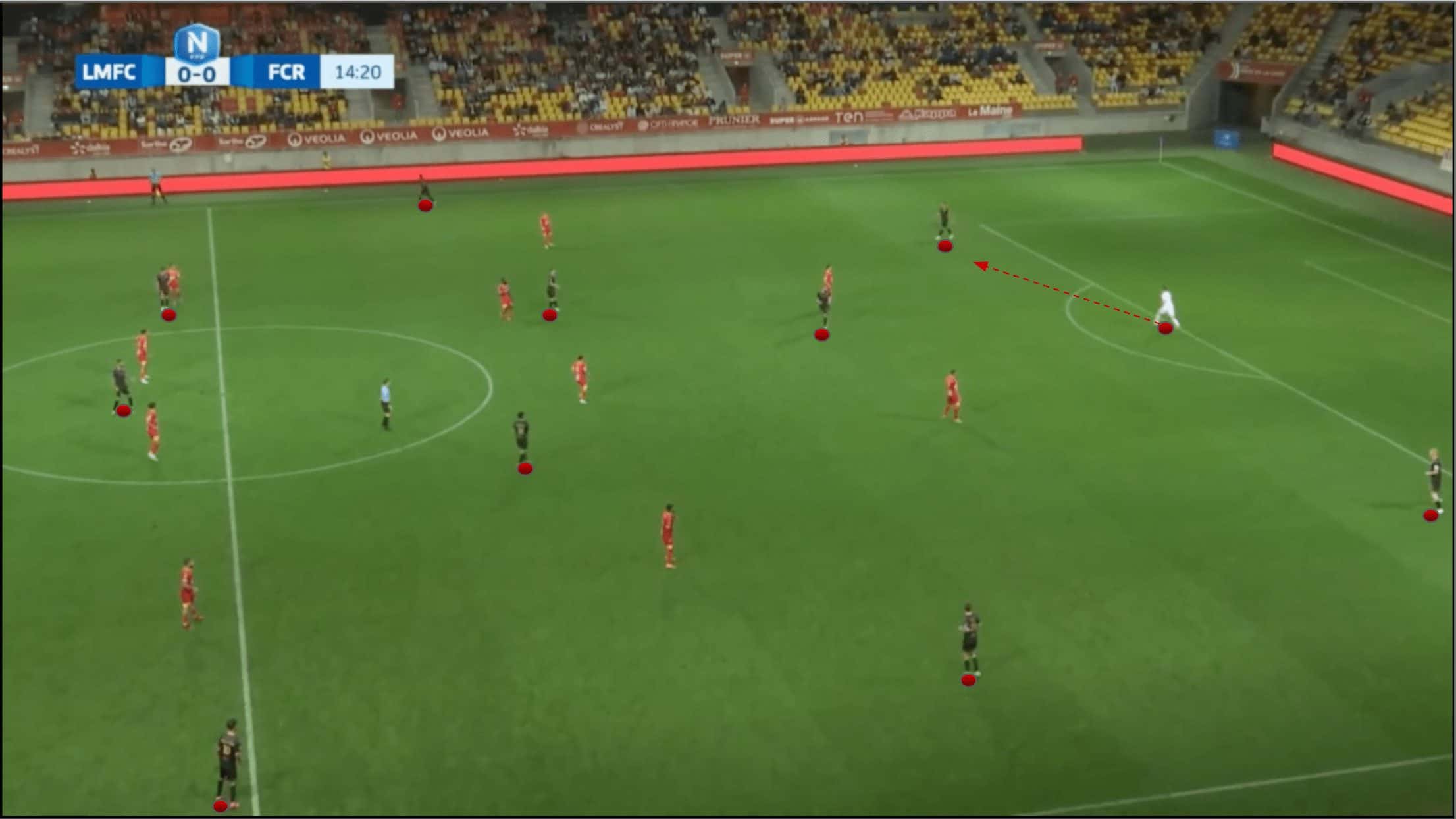
Here in figure 1, we see Les Diables Rouges’ general offensive shape, with the ‘keeper stepping out between the two centre-backs who’ve split wide, pushing the full-backs further upfield.
The wide attackers will typically come inside a bit at this point. At the same time, the central midfielders stagger their positioning to all be standing on different horizontal and vertical lines — a standard principle for facilitating quicker and easier ball progression while being more difficult for the opposition to mark.
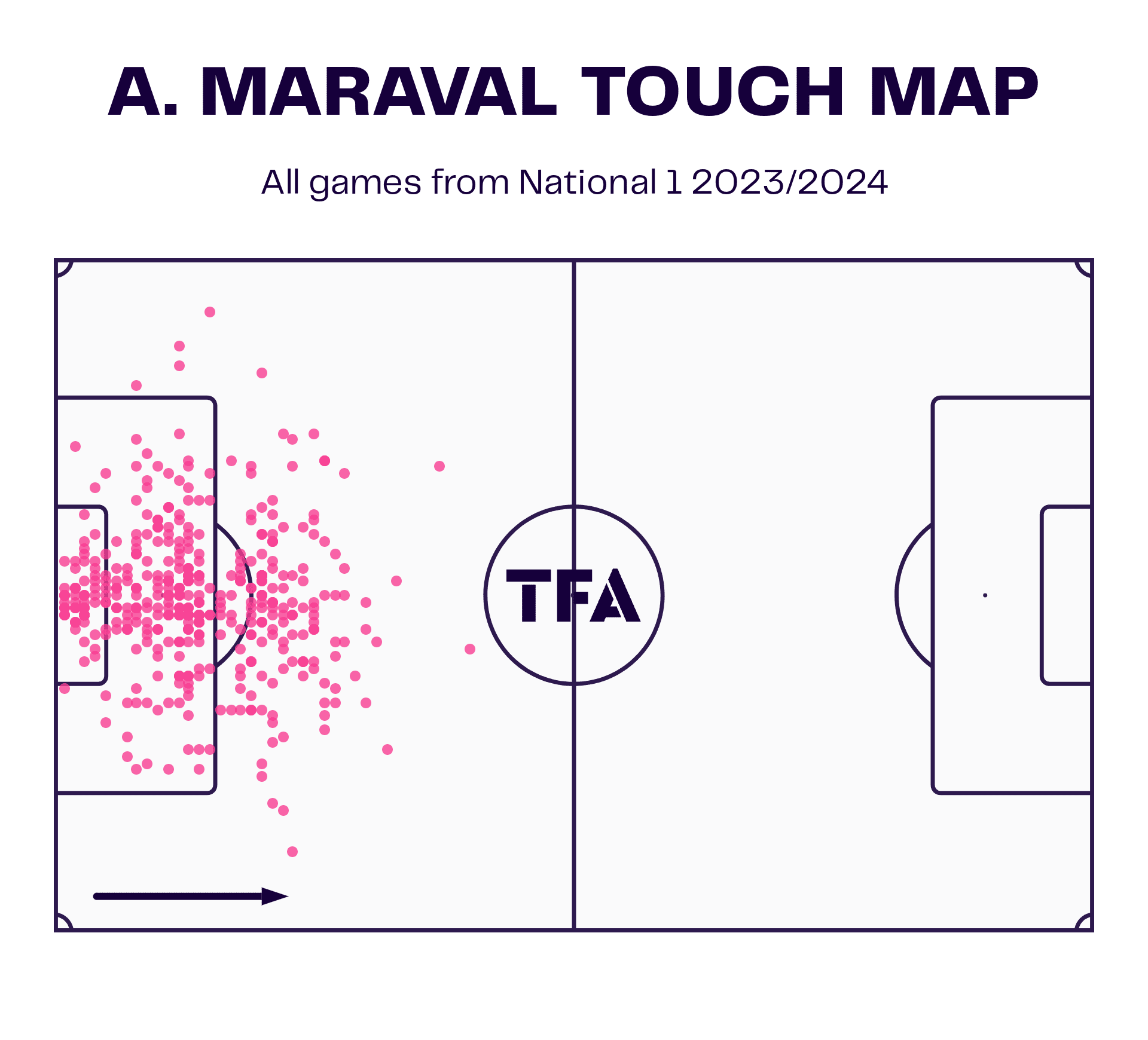
Indeed, Rouen’s ‘keeper, Axel Maraval, who had been playing with Nîmes Olympique in the second-tier last season, has been active in his team’s build-up play this term, frequently stepping out in between the centre-backs to receive passes and get involved in play.
His passing isn’t always perfectly accurate, but in general, he performs the role well, especially when, the majority of the time, he’s not required to play balls that are too challenging.
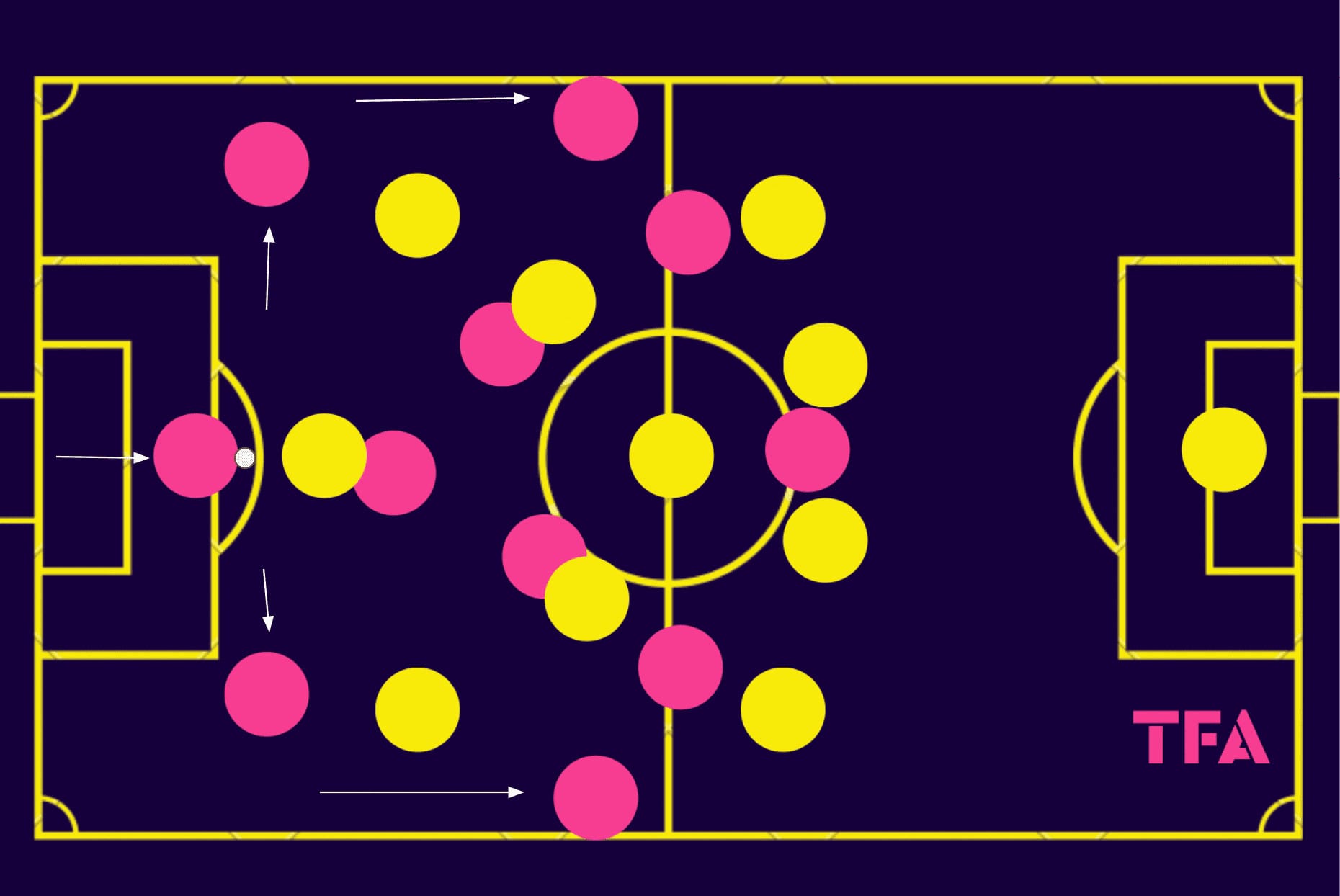
We’ve illustrated how his movement up between the centre-backs and their split into slightly wider areas affects the overall team shape in figure 3. This effectively creates a back-three in possession without Rouen needing to sacrifice a midfielder or attacker for an extra centre-back.
This comes with some risk in that a loss of possession obviously leaves the opposition with an open goal to target. However, a loss of possession deep in this area would be quite dangerous regardless. Rouen are very cautious and methodical in build-up, so it shouldn’t be a significant concern; they don’t take many risks and lose the ball cheaply often at all.
This usage of the goalkeeper is a growing trend that I personally really enjoy seeing and think we’ll see a lot more of over the coming years. It yields many benefits, such as the fact that the team basically creates a guaranteed +1 advantage outfield that they can use to break through the opponent’s shape and create goalscoring opportunities.
We can see in figure 3 how the short passing options can be covered quite well by the opponent’s press. As we move on into figure 4, we’ll look at some ways in which Rouen look to deal with this issue.
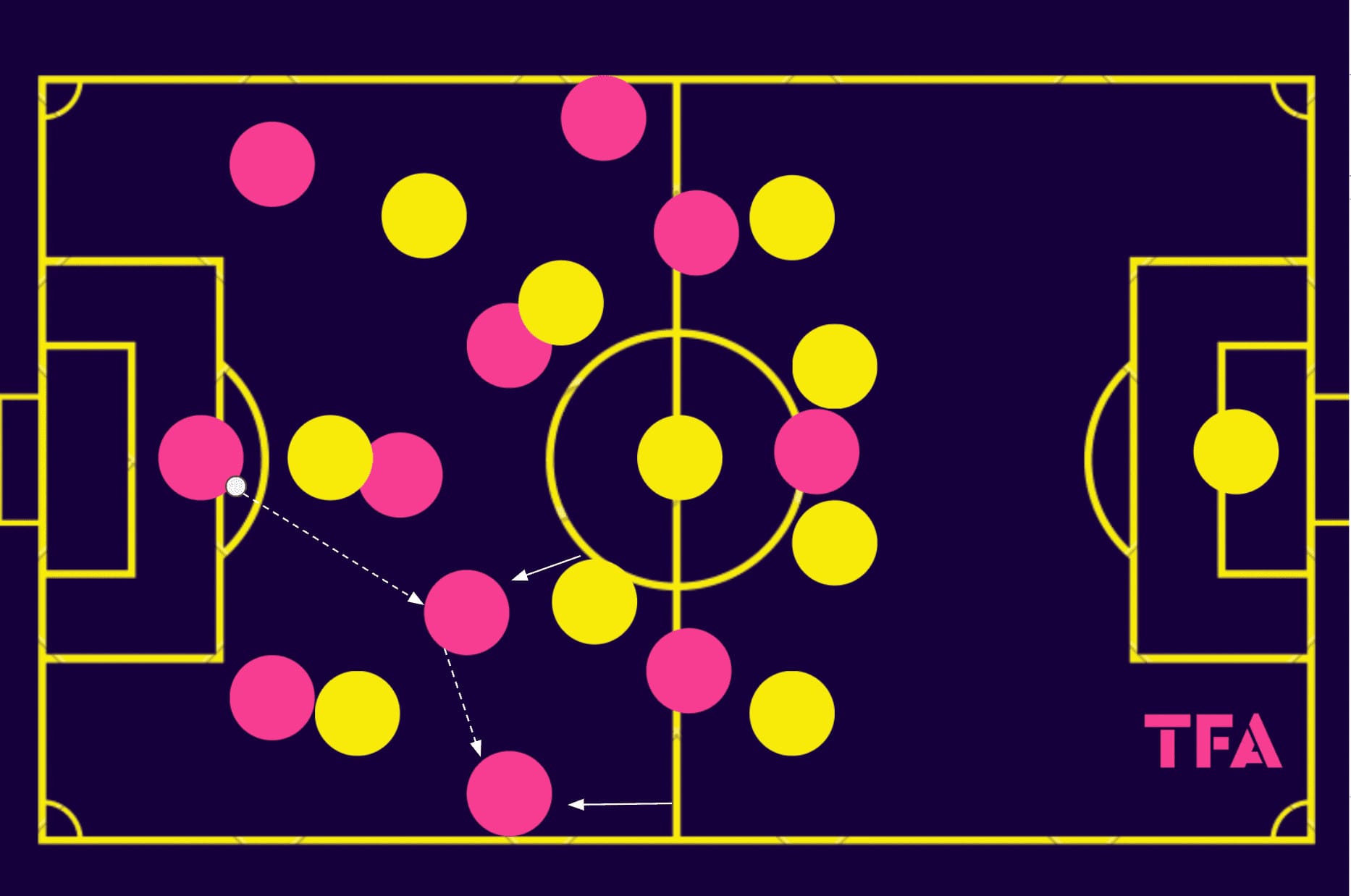
Their primary solution to this is movement in the midfield. Take figure 4 as one example — here, the right central midfielder drops off to become a viable short passing option for the ‘keeper, losing his marker shortly while quickly dropping to receive.
After getting on the receiving end of that first pass, he could, for instance, circulate the ball out to the full-back, creating a 4v3 for Rouen out wide versus the defenders.
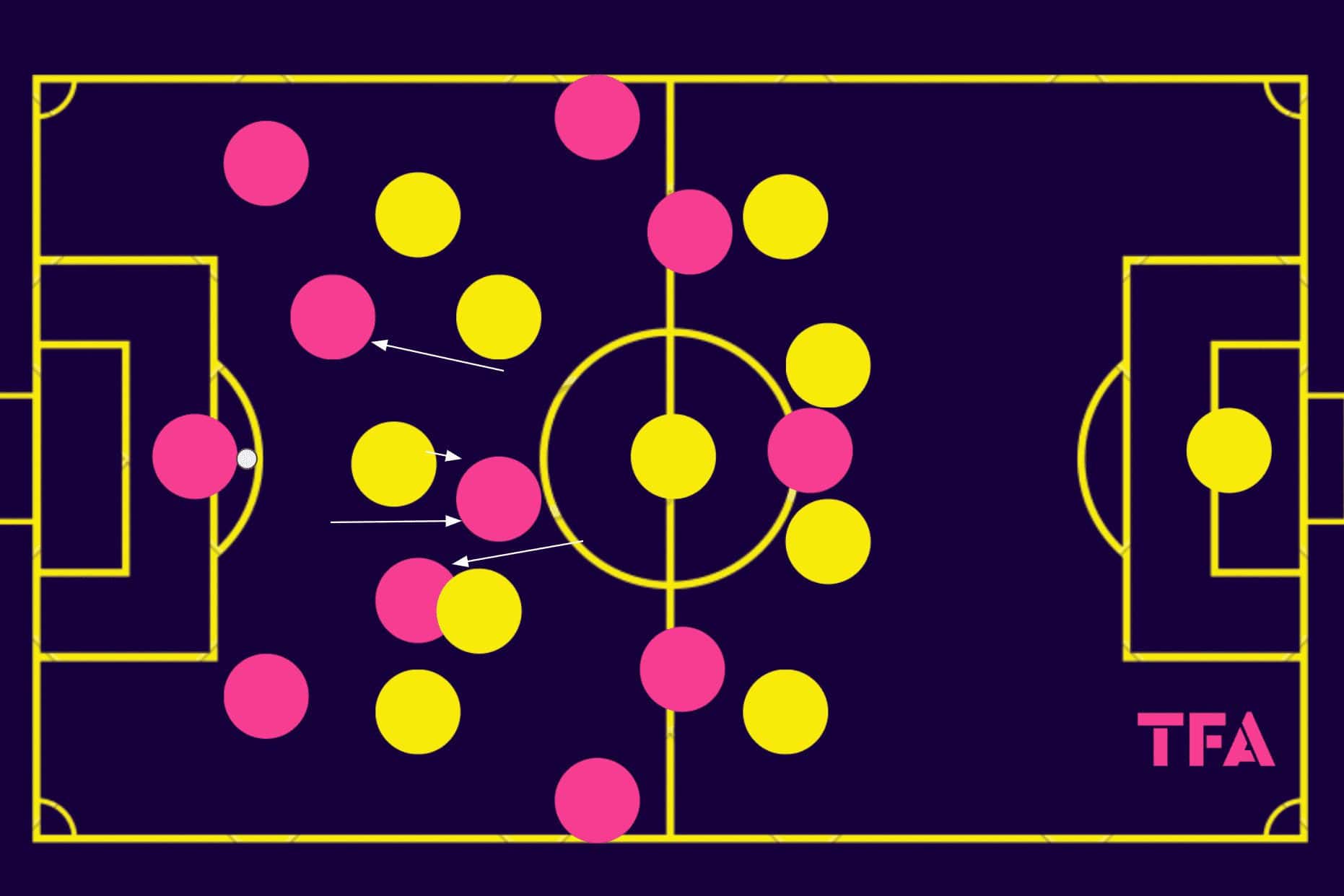
Another rotation in Rouen’s midfield might see the holding midfielder actually push up, aiming to drag the centre-forward away a little bit while the other midfielders drop. All going to plan, this should open the pathway for one of Rouen’s midfielders to receive a short pass deep and progress their side from the bit of space they enjoy as a result.
Positional rotations in central midfield are a vital aspect of D’Ornano’s side and their possession play, which allow them to progress without having to play longer, riskier passes.
At times, they will go long, but aiming to find a winger or striker to feet or to chest with a pass. The ball from the back to the winger is a common one as Rouen often create a 2v1 versus the opposition’s full-back out wide, as we saw above, meaning if the pass is played gently enough to be pretty easily controlled, those two wide players can quickly combine and progress into the final third around the outnumbered full-back.
Another benefit of the goalkeeper stepping out is especially against two-striker formations; coaches will often like to create a three-player backline to outnumber the first line of the opposition’s press.
By bringing the ‘keeper up, D’Ornano can achieve this without needing to drop a midfielder or full-back, meaning they can keep those problems of the central overload or wide overload while still generating that +1 in the first line.
Ball progression: Ahmad Allée
Moving on to the progression phase, the key here for Rouen really is the midfielder, Ahmad Allée.
We published an analysis of this talented player back in 2021/22 in which we dubbed him Championnat National’s answer to Andrea Pirlo. While that was somewhat hyperbolic, of course, the point stands that at this level, he performs that role of a deep-lying playmaker who can spread the ball around the pitch and, crucially, advance his team into valuable areas with pinpoint passing and an astonishing passing range very well.
Allée previously played under D’Ornano at Stade Briochin. When Rouen were promoted to France’s third tier for the 2023/24 campaign, it’s clear both sides were thrilled to link back up again.
So, how has D’Ornano utilised Allée this term?
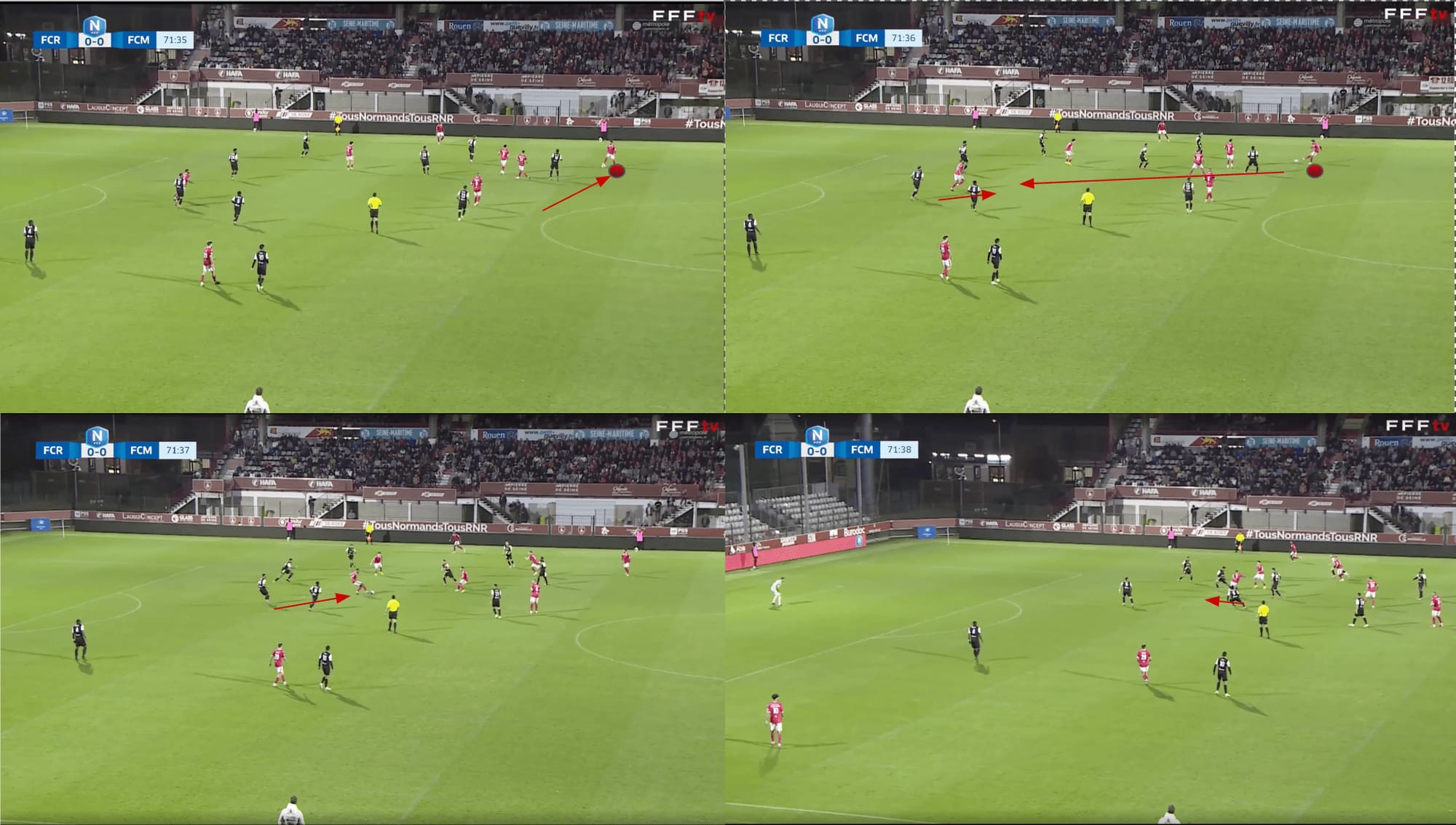
Firstly, of course, the centre of the pitch is very often the most congested area, and as a result, players need help finding space there. Allée needs space to turn, get his head up and progress his team, so he will often leave the centre in order to get on the ball with time and space to pick out a progressive pass.
Take figure 6, for example. Here, we see how Allée has dropped into more of a typical right-back position than anything else, getting himself on the ball, raising his head and firing a pass into a dropping striker’s feet.
The pass is very accurate and well-weighted, allowing the striker to control it in a very valuable area, quickly link up with the wide attacker positioned just beside him and create an opportunity to break in behind the opposition’s backline.
This is just one very basic example of how Allée operates within D’Ornano’s Rouen system. The midfielder will drop into deeper areas, such as the right-back position or even in between the centre-backs in more advanced stages of possession when the goalkeeper doesn’t continue coming out to get on the ball with time and space to pull off effective progressive passes such as the one we saw here.
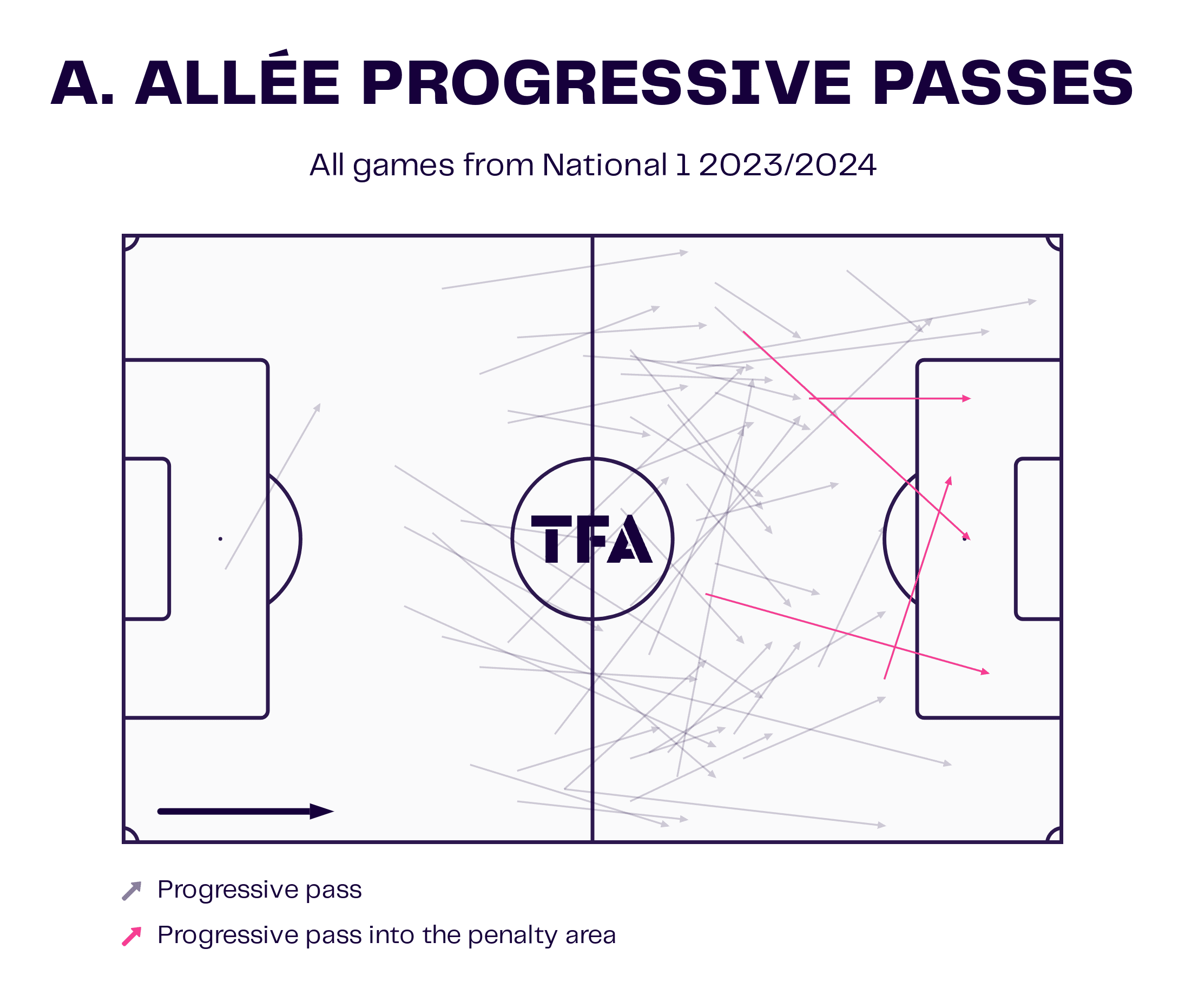
Here, in figure 7, we have got all of Allée’s progressive passes from 2023/24 mapped out and nicely illustrated. This highlights how varied the midfielder’s positioning can be as he doesn’t always drop into the exact same positions time after time — he will drop into different areas, keeping the opponent guessing as to where he will turn up and where Rouen’s primary progression threat is coming from.
He’s a very intelligent footballer with good spatial awareness who performs well under the guidelines set out for him by D’Ornano — this is a coach-player partnership that works exceptionally well.
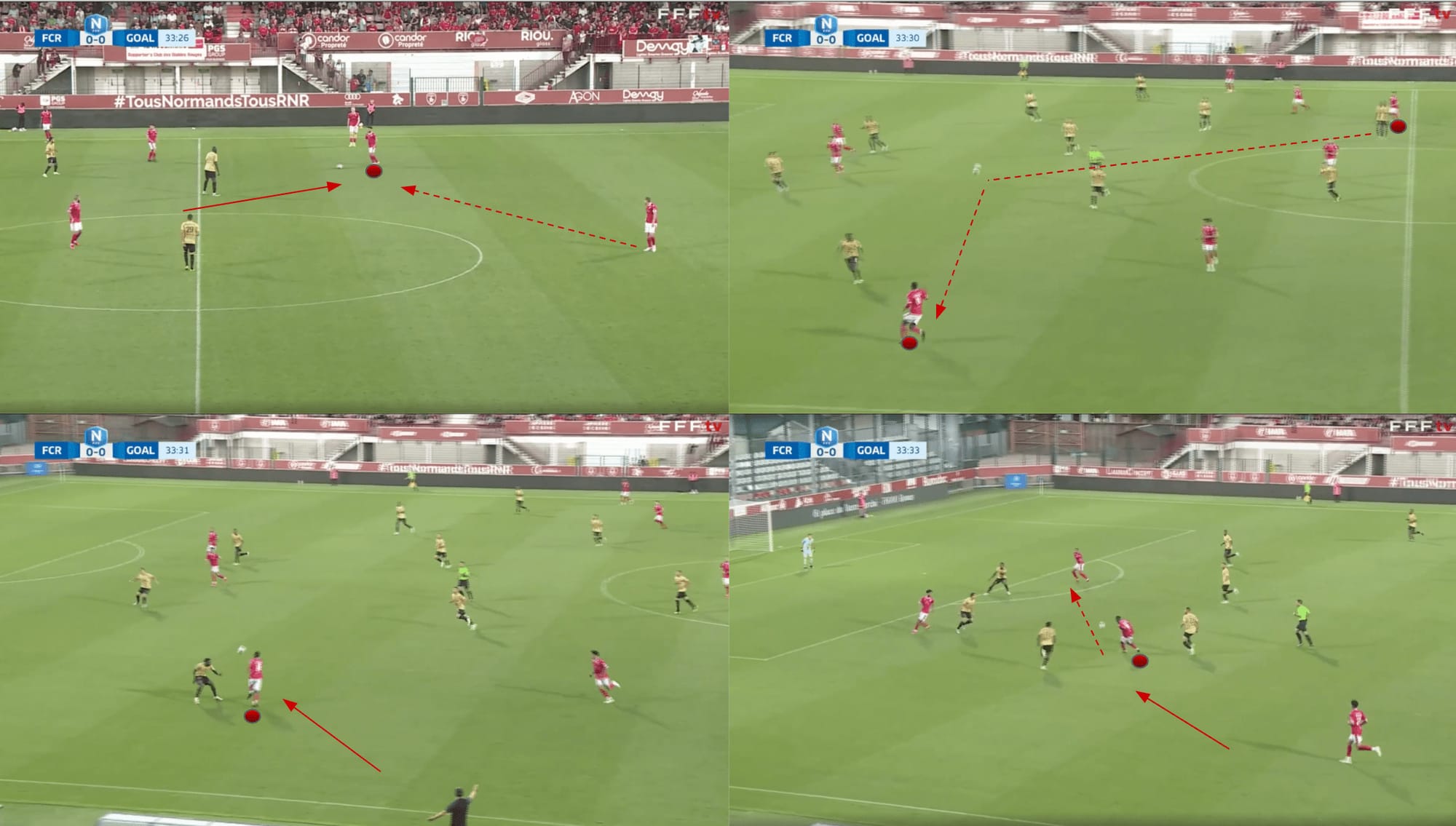
Allée’s long passing is a crucial aspect of his game that can help his team break away in behind the opposition’s backline or, as shown in figure 8, can facilitate big switches of play that create favourable conditions for a wide attacker to carry the ball at the defence and generate a decent opportunity.
In this case, Allée dropped in between the centre-backs before getting his head up and floating the ball out to the winger on the opposite side of the pitch with a beautifully well-weighted pass. The winger was able to control without much trouble and quickly carry inside, firing the ball into a central attacker’s feet and creating a valuable final third entry for Rouen.
All of this was made possible by Allée’s positioning and exquisite passing quality — a tool D’Ornano is well aware of and aims to make good use of.
Chance creation: Ibayi’s movement, transitional attacks and wingers’ dribbling quality
Springing the ball into valuable goalscoring positions and flicking that switch to turn their possession dominance into real chances hasn’t been the most straightforward task in the world for Rouen this term. This is one area in which they can still improve.
However, thanks to their wingers’ creativity and their forwards’ movement, Les Diables Rouges have done well at generating high-quality chances when they do get the ball into good goalscoring positions this term.
Rouen have an xG of 14.37, which ranks highly among Championnat National sides. However, they’ve actually taken the second-fewest shots (7.99 per 90) in the league this term. The reason for their solid xG numbers is their xG per shot standing at 0.167 — a very high number when compared with their league rivals.
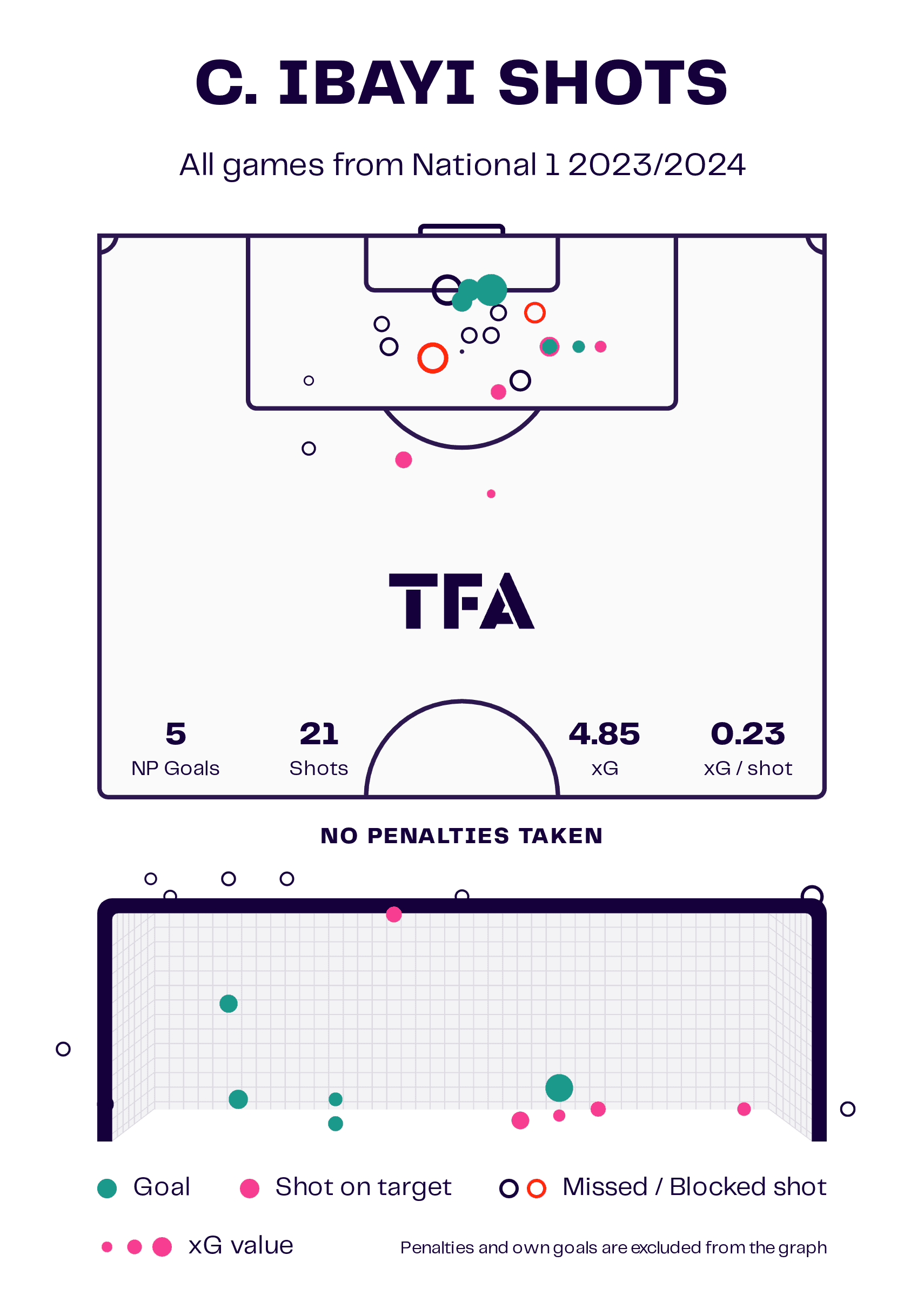
The Normandy-based side’s main centre-forward this season has been 28-year-old Christopher Ibayi, who joined from FC Versailles in the summer of 2022. He finished last season with 22 goals in 28 league games, playing a crucial role in his side’s league win and promotion.
This term, he’s bagged five goals in 10 league games thus far — five goals that have resulted from a total of 21 shots. Those 21 shots generated 4.85 xG, averaging 0.23 xG per shot.
Ibayi does exceptionally well at peeling away from defenders at the very last moment before the ball is played to him, now in space, to finish from high-percentage areas.
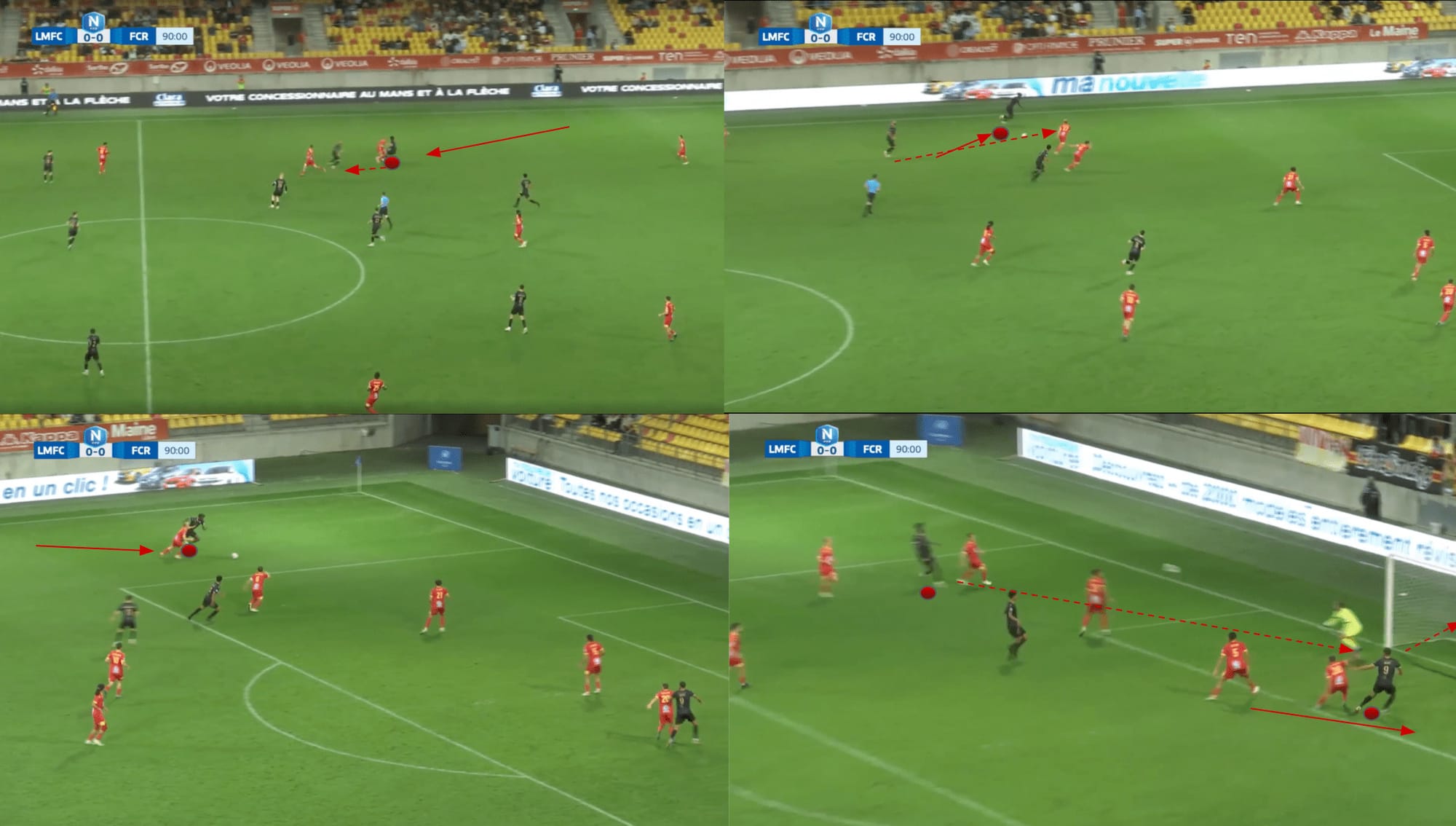
We see one example of this in figure 10. Here, in the bottom left image, we see Ibayi positioning himself on the defender’s blind side as the winger carries the ball into a dangerous crossing position.
As the cross comes in in the bottom right image, we can see how the striker has just peeled away off the defender’s shoulder as the cross comes in, setting himself up to meet the ball in space while occupying a very high percentage position. All the striker has to do here is meet the ball, and a goal will come, which is precisely what happens, highlighting the value of a striker who can make these kinds of movements and find space in these high-value positions.
In the top two images in figure 10, we see how this attack starts with the ball being regained due to some combined pressure between the left-winger and left central midfielder, which forces the ball carrier into an awkward situation, ultimately losing possession as a result.
While Rouen typically keep most of the ball in their games, their out-of-possession play has as big if not an even bigger role in their chance creation than what they do with the ball.
They have struggled, at times, to break down opponents in settled defensive phases, but in transition, when the opponent will be less organised at the back, their wingers, in particular, have found a lot of joy, as we see in this example.
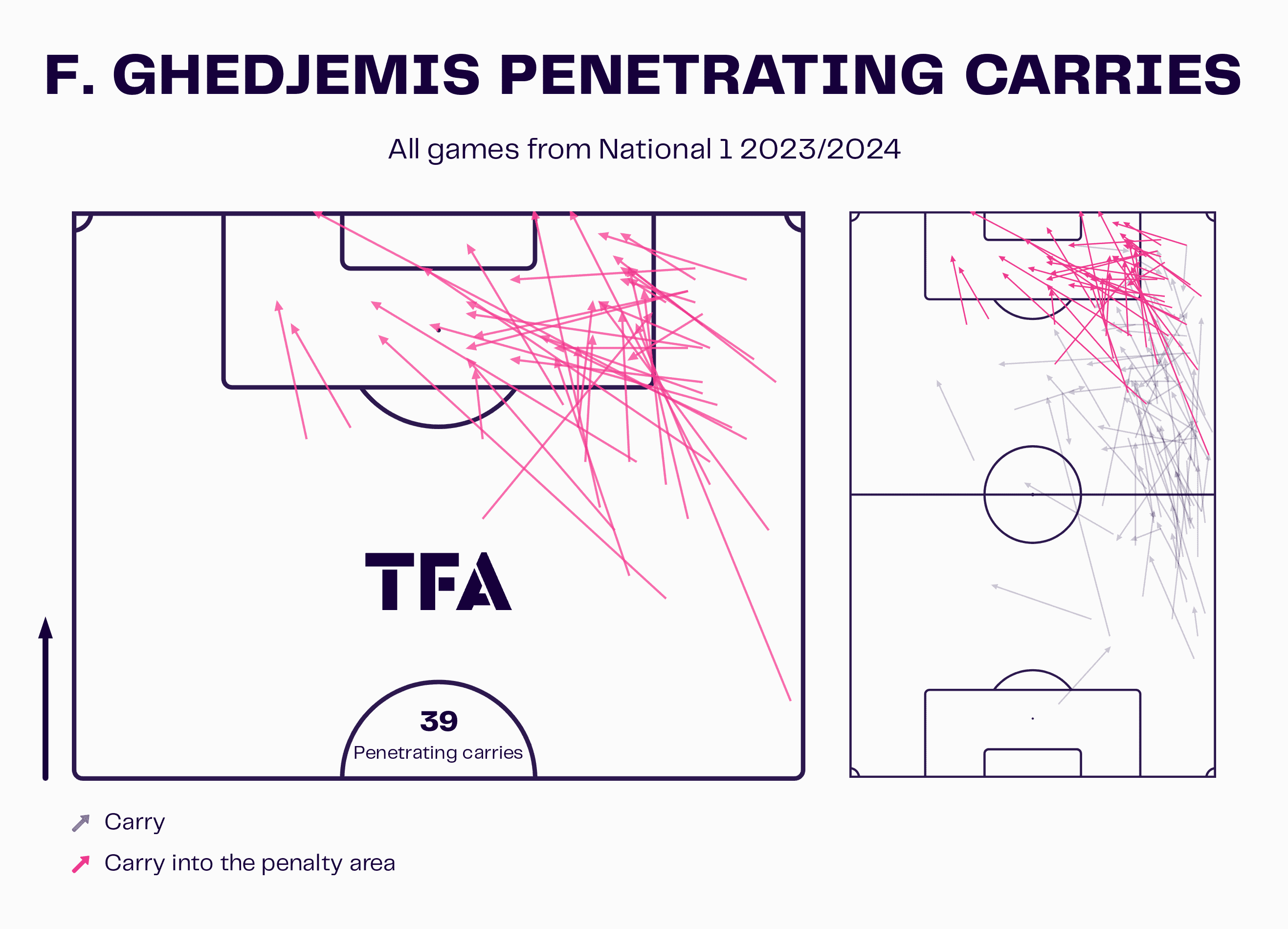
Most of Les Diables Rouges’ direct chance creation has come via the wings, where they’ve got some tricky dribblers capable of carrying the ball into high-value positions from where they can create good chances, such as Farès Ghedjemis who’s typically deployed on the right.
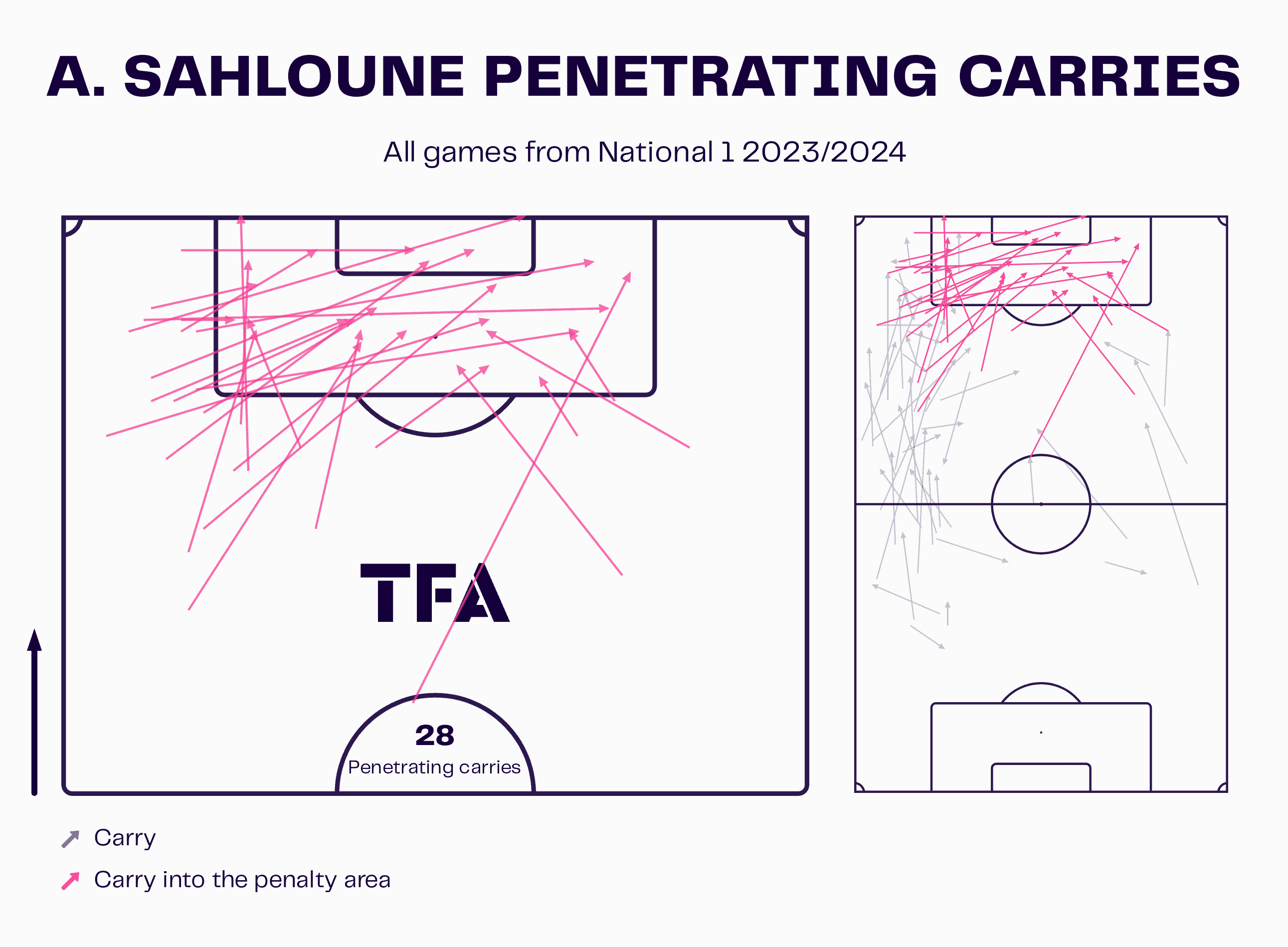
Abdeljalil Sahloune has mainly been deployed on the left, then, and his progressive carries map resembles that of Ghedjemis quite a lot, signifying the similar roles of both wingers and how Rouen’s setup frequently finds them in space to drive at the defence either as a result of the wide overloads or Allée’s passing range, as previously analysed.
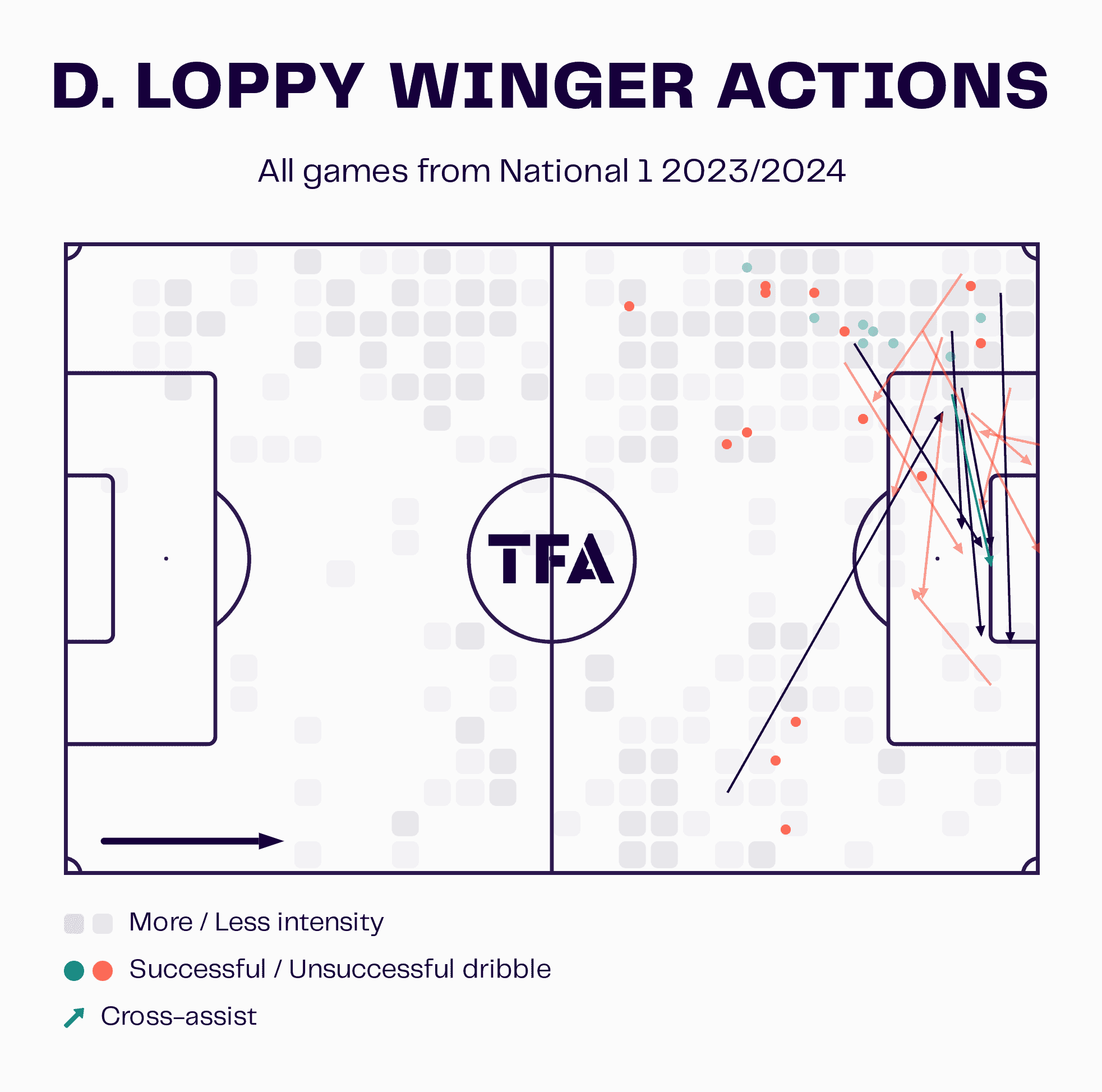
Damien Loppy has enjoyed fewer minutes than the other two wingers mentioned but has still managed to create plenty of chances this term — more than Sahloune and Ghedjemis in terms of xA, in fact.
Loppy’s dribbling quality has been outstanding this season when played, with the winger frequently progressing his team into valuable positions from wide thanks to his technical quality and pace.
Overall, it’s clear how Ibayi’s intelligent movement, transitional attacks and the wingers’ dribbling quality have all combined to play a vital role in Rouen’s chance creation this term.
Out of possession
For our final section of analysis, we’re going to take a look at D’Ornano’s tactics without the ball in the 2023/24 campaign. Rouen have conceded only nine goals in their 10 games so far — a solid defensive record — while they’ve also got a relatively low xGA of 10.24. Their opponents haven’t managed to generate that many shots against them, which has played a major part in their success this season.
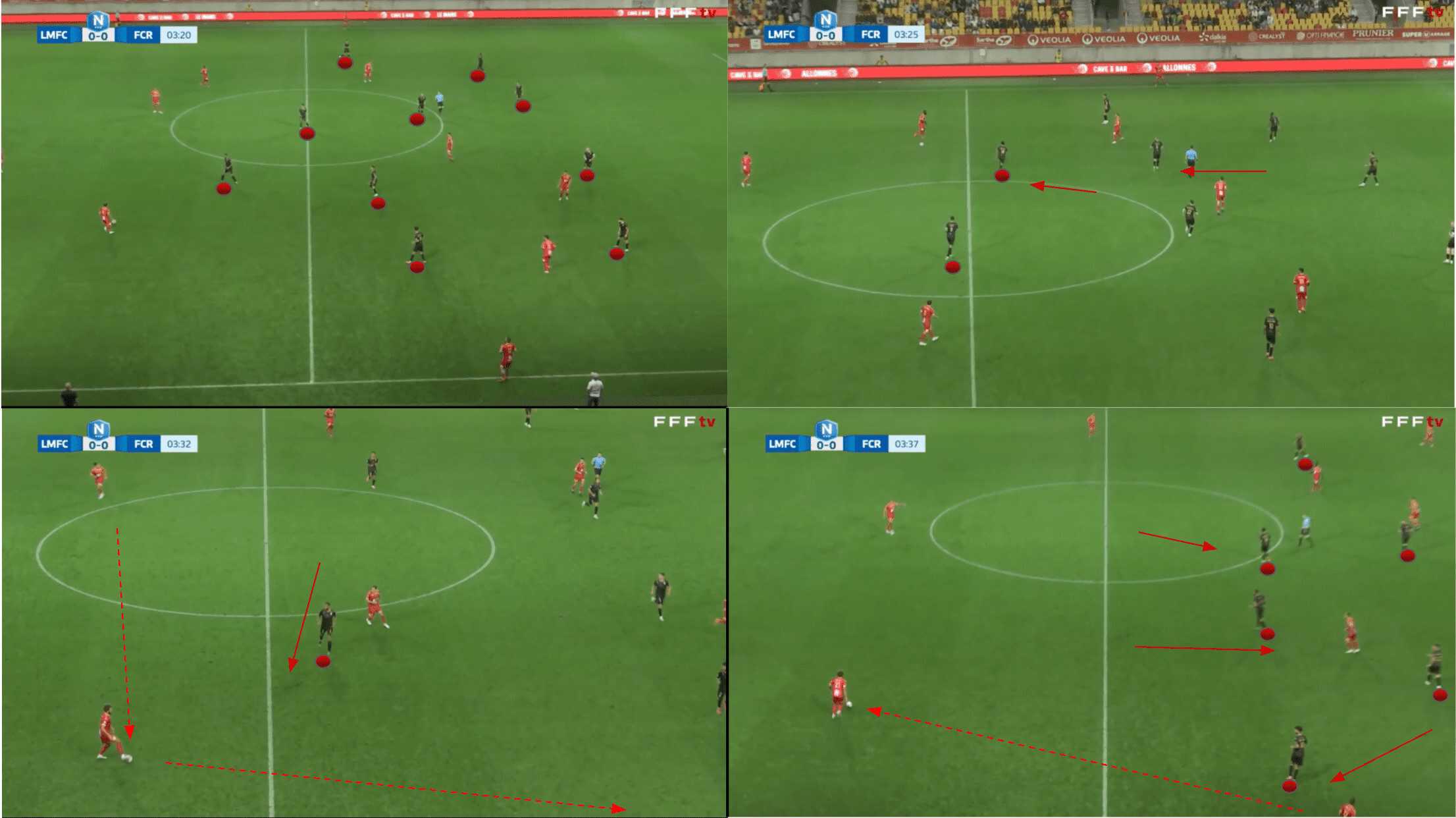
Les Diables Rouges have primarily set up in a 4-1-4-1 base shape this season, which they use to defend in higher regions. However, D’Ornano’s side aren’t very aggressive without the ball, primarily setting up in a mid-low block.
In their mid-block — and when moving into deeper zones of the pitch to defend, their 4-1-4-1 can become a 4-4-2, which we see occur as the play in figure 14 moves from the top-left image to the top-right.
One central midfielder advances next to the striker, while the holding midfielder advances next to the other central midfielder.
As a result, with two strikers, Rouen can access the centre-back on either side more quickly than if one stiker were trying to cover them both while still keeping the ball into midfield in their cover shadow.
With their 4-4-2 mid-block, Rouen are hoping to cover as much of the pitch as possible, ensuring no easy progression is possible anywhere. This can sometimes leave some space in the centre, especially when the ball is played out wide, and the winger presses aggressively, as was the case just before the bottom-right image of figure 14 was taken.
However, all going to plan, the strikers should be able to drop in and cover any space that opens up in these scenarios, ensuring all significant gaps remained plugged and the opposition continue to struggle with progression.
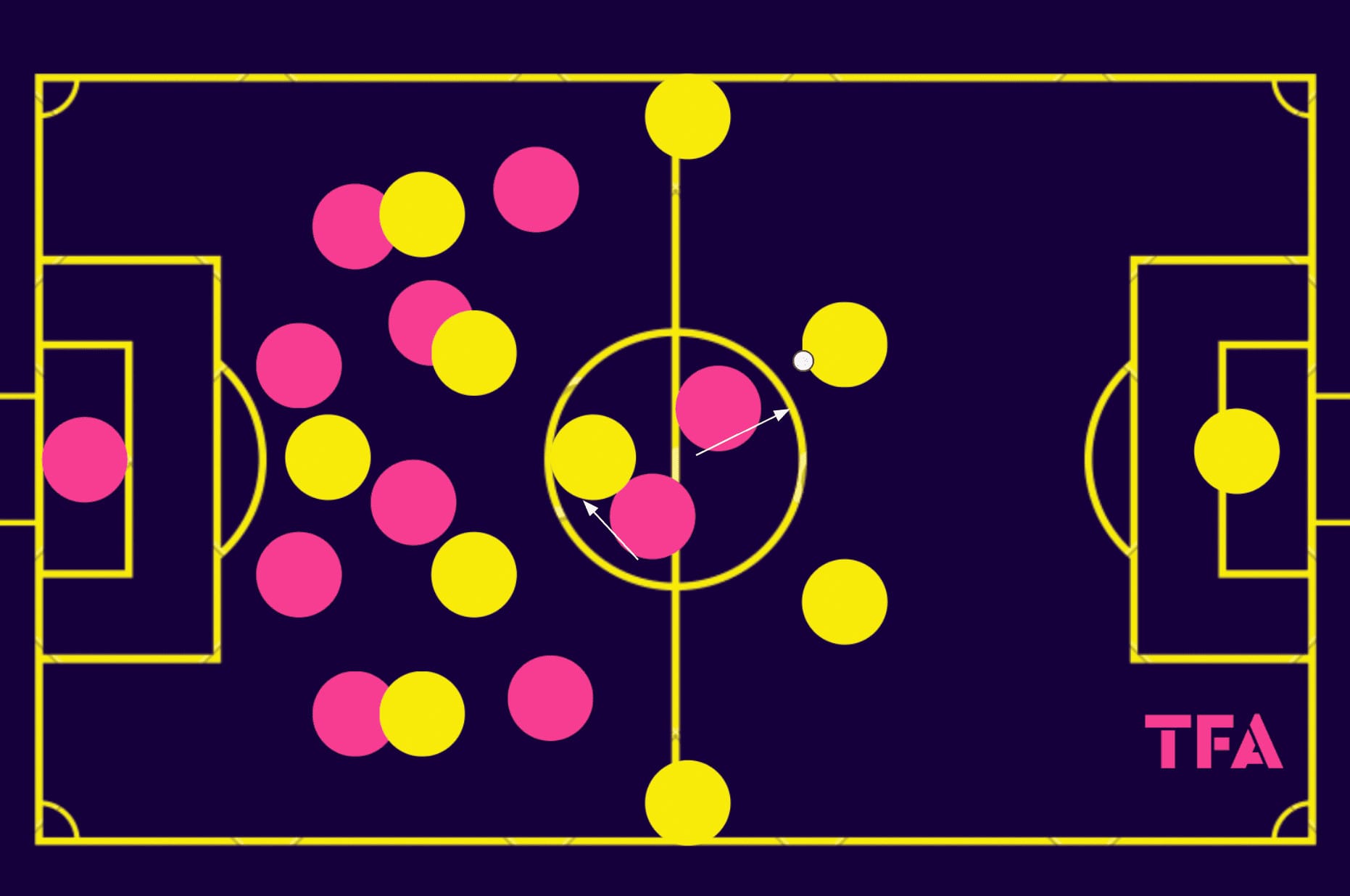
We see an example of their 4-4-2 laid out in figure 15. Here, we see the ball with the opposition’s right centre-back, so Rouen’s left striker presses. Meanwhile, their right-striker drops onto the holding midfielder, picking him up in a more man-oriented fashion.
The ball-near striker will press in relation to the ball, and the ball-far striker will then man-mark the holding midfielder until the switch across the backline occurs and they need to swap roles.
At the same time, the rest of the team defends in a position-oriented manner, not moving too far from the position we see them in above.
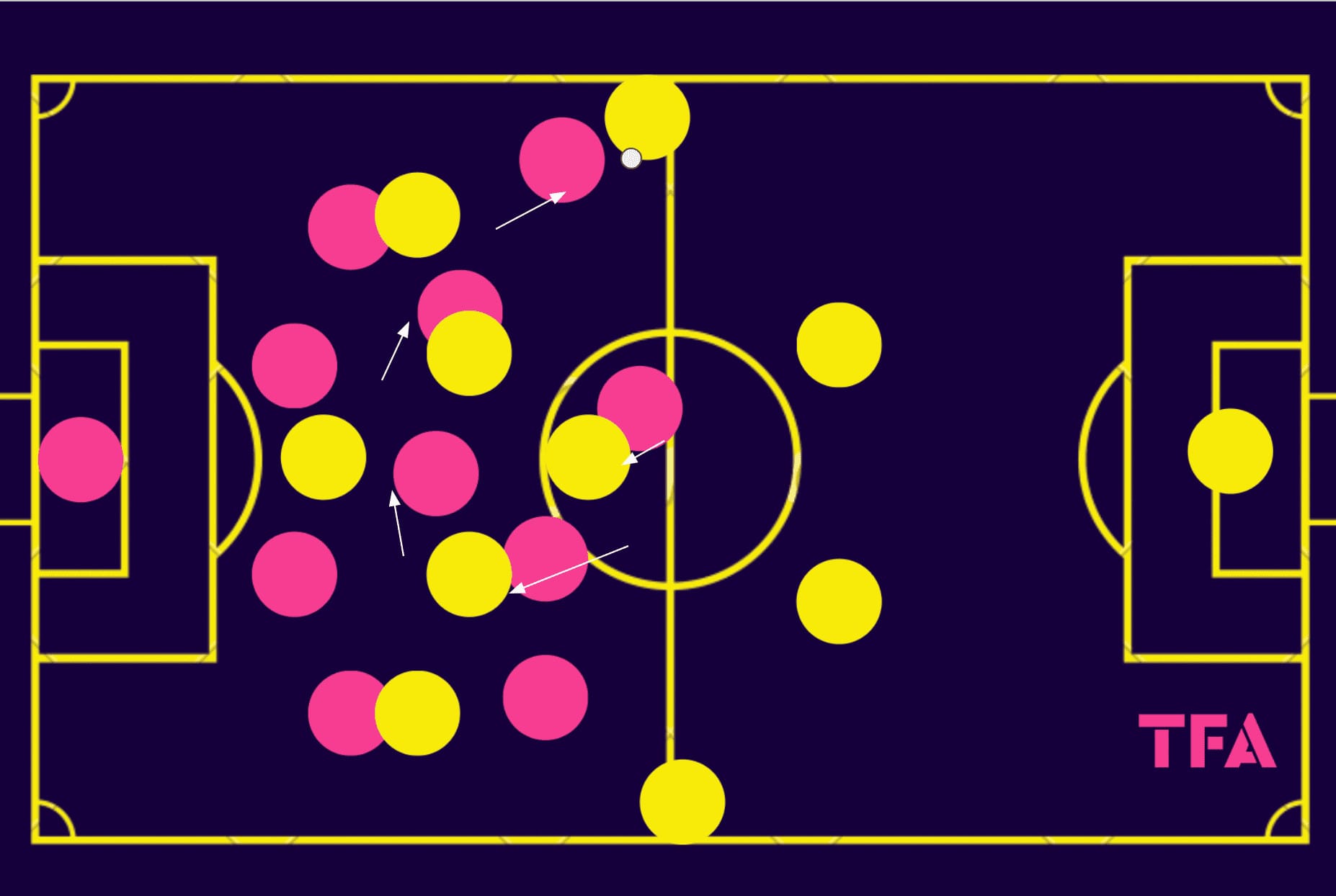
As the ball is played out wide, the strikers drop, leaving the back pass open but plugging gaps in the midfield and preventing any further progression beyond the full-back.
Rouen aren’t the most aggressive team defensively, but they are very good at frustrating their opponents and stifling their progression through some excellent organisation.
Conclusion
To conclude our tactical analysis, D’Ornano has engineered fantastic success with this newly-promoted side in Championnat National this term thanks to some bold in-possession tactics designed to increase their chances of sending the ball forward into a valuable position while not having to take too many risks in terms of their pass selection if they can help it.
Their quick transitions have been important in chance creation, and without the ball, solid organisation within their shape, with all players knowing what’s required of them, has helped make them very tough to break down. At the moment, Les Diables Rouges simply represent a very good Championnat National side who shouldn’t be underestimated this season.
In terms of personnel, Axel Maraval, Ahmad Allée, Christopher Ibayi, Abdeljalil Sahloune, Farès Ghedjemis and Damien Loppy have, in particular, stood out as key figures within this team in 2023/24 and will all likely have played key roles if Rouen are to be promoted come the end of the campaign.





Comments